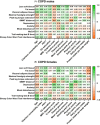Biological sex and age-associated changes in muscle and brain health in Chronic Obstructive Pulmonary Disease: A large cross-sectional study
- PMID: 40524405
- PMCID: PMC12242101
- DOI: 10.1002/ncp.11333
Biological sex and age-associated changes in muscle and brain health in Chronic Obstructive Pulmonary Disease: A large cross-sectional study
Abstract
Background: Biological sex plays a role in systemic features of patients with Chronic Obstructive Pulmonary Disease (COPD). We investigated whether male and female COPD patients show distinct trajectories in muscle and brain health decline during aging.
Methods: In total 228 patients (age >50 years) with stable COPD (GOLD: II-IV) were stratified into four groups based on their sex and age (50-70 years vs ≥70 years). Body composition (DXA), muscle strength (dynamometry), cognitive function and well-being (assessments and questionnaires), and risk factors of poor systemic health were analyzed in these groups.
Results: Body weight and lean mass remain unchanged with aging. The ≥70 years males showed higher visceral adipose tissue and lower muscle strength whereas females showed lower fat mass and fat-free mass index, and worse cognitive performance compared with their younger counterparts (P < 0.04). In males, lower physical activity was associated with higher visceral adipose tissue and lower muscle function, whereas poor cognition was associated with low O2 saturation. In females, lower muscle function was associated with higher age, dyspnea and lower caloric intake and physical activity, whereas mood disturbance and poor cognition were associated with smoking pack years (P < 0.05).
Conclusion: Aging in male COPD patients is characterized by metabolic syndrome features and muscle weakness whereas aging in female COPD patients is associated with weight loss, sarcopenia, and cognitive decline. The observed systemic changes were influenced by different combinations of risk factors in male and female COPD patients. Our findings indicate that sex-specific therapies need to be considered when treating older patients with COPD.
Keywords: COPD; aging; cognition; muscle function; risk factors; sex differences.
© 2025 The Author(s). Nutrition in Clinical Practice published by Wiley Periodicals LLC on behalf of American Society for Parenteral and Enteral Nutrition.
Conflict of interest statement
None declared.
Figures



Similar articles
-
Inspiratory muscle training, with or without concomitant pulmonary rehabilitation, for chronic obstructive pulmonary disease (COPD).Cochrane Database Syst Rev. 2023 Jan 6;1(1):CD013778. doi: 10.1002/14651858.CD013778.pub2. Cochrane Database Syst Rev. 2023. PMID: 36606682 Free PMC article.
-
Diagnostic value of different skeleton muscles in elderly COPD patients with sarcopenia.Eur J Med Res. 2025 Jul 2;30(1):560. doi: 10.1186/s40001-025-02856-1. Eur J Med Res. 2025. PMID: 40604893 Free PMC article.
-
Pulmonary rehabilitation for chronic obstructive pulmonary disease.Cochrane Database Syst Rev. 2015 Feb 23;2015(2):CD003793. doi: 10.1002/14651858.CD003793.pub3. Cochrane Database Syst Rev. 2015. PMID: 25705944 Free PMC article.
-
Computer and mobile technology interventions for self-management in chronic obstructive pulmonary disease.Cochrane Database Syst Rev. 2017 May 23;5(5):CD011425. doi: 10.1002/14651858.CD011425.pub2. Cochrane Database Syst Rev. 2017. PMID: 28535331 Free PMC article.
-
Different Properties of the Erector Spinae and Multifidus Muscles on Physical Performance in Patients With Chronic Obstructive Pulmonary Disease.Int J Chron Obstruct Pulmon Dis. 2025 Apr 29;20:1299-1308. doi: 10.2147/COPD.S513153. eCollection 2025. Int J Chron Obstruct Pulmon Dis. 2025. PMID: 40322200 Free PMC article.
References
-
- Jestin‐Guyon N, Ouaalaya EH, Bernady A, et al. Sex‐related differences and FEV1 decline among COPD patients: the French Palomb cohort. In: 06.03—Tobacco, Smoking Control and Health Education. 60. European Respiratory Society; 2022: 4514.
MeSH terms
Grants and funding
- R56 HL141744/HL/NHLBI NIH HHS/United States
- R56HL141744/National Heart, Lung, and Blood Institute of the National Institutes of Health
- R01HL095903/National Heart, Lung, and Blood Institute of the National Institutes of Health
- R01 HL095903/HL/NHLBI NIH HHS/United States
- George Abramson Donation, internal Texas A&M University grants
LinkOut - more resources
Full Text Sources
Medical

